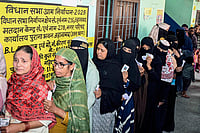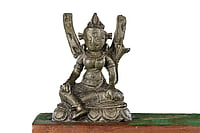Prime Minister Narendra Modi recently visited the US, and as it happens with all his visits to foreign shores, the ‘Indian diaspora’ is in focus again. A carefully curated set of its members donned traditional finery, performed dances and kirtans, and lined up at various venues where they chanted slogans eulogising Modi and India, the homeland.
Indian media has gushingly covered these events to claim that the diaspora adores Modi, and that ‘Indian culture’ is alive and well in the far-flung corners of the world. Isn’t it charming that the coverage is encouraging us to think how much love the diaspora has for the motherland, and how they express it in song and dance and spirited slogan-shouting?
Cynics may well insinuate that some of this crowd was ‘flown from India’ or was rustled by overseas front organisations of the ruling party, but that raises a very interesting question— why does the diaspora matter to the homeland, as much as the homeland to the diaspora? The same question is raised by the other subset of the diaspora which, as in the visits of many previous prime ministers abroad, will protest against the visit, raising issues concerning human rights abuses, restrictions on press and civil society, and democratic deficits back in India.
In media coverage and the perception of a sizeable population back home, these will be called traitors who have ‘sold out’ to ‘breaking India forces’. The diaspora as uncritically affirming the goodness of the motherland, and as implacably critical of political figures and conditions back home, represents two broad streams of people who left India years, decades, even centuries ago, who long for ‘home’ even as they make other homes elsewhere.
Becoming Diaspora
The literal meaning of ‘diaspora’ as ‘scattered seeds’ lends a sense of naturalness to the global spread of culturally- specific people. Yes, we too were carried by wind and water to distant places, much as seeds are, but other things were at play—history and political economy, for example.
Once, indentured labour was hoodwinked into making perilous journeys to the sugar islands from where it had little chance to return. Then, workers and small traders went to East Africa under the aegis of the Empire, and then moved on to the UK and Canada after the racist attacks of the 1970s. Then, there were waves of guest workers coming to the Anglosphere in the aftermath of World War II, when Britain “needed” manual and white collar workers. This was followed by the infamous ‘brain drain’ starting in the 1970s, when ‘Indian talent’ did not find outlets in a stagnant economy and went abroad to explore its potential. More recently, techies and finance sector workers, farm workers, students and, increasingly, migrants and asylum seekers have made tracks to distant shores. Some journeys are perilous, others luxurious. The 18 million people of the Indian diaspora contain within them different stories of mobility and settlement.

As I prepared for my diasporic life in the late-1980s, packing my bags in Patna to leave for Philadelphia, an aged relative, who for the most part confined herself to her bedroom, made a point to visit us. “Rok le Bachhiya, jaito ta laut ke naa aito!” (Stop him, Bacchi, if he leaves, he will never come back), she said to my mother. Her own much-loved son had gone to a remote town in Canada, married locally and was raising his family there—she had not seen him in 23 years.
In the days of bad telephone connectivity, well before the global communication revolution, time and space had reduced their once-intense love to the thinnest of bonds, the occasional letter arriving with reducing frequency. She equated his not coming back to the motherland with his abandonment of his mother.
Between his time of departure and my time of leaving, returning home had become more common, and my mother was reassured on that front. She was anxious, of course, about the usual things. Will I marry someone there? She remembered a story from Dharmyug, the literary Hindi magazine, in which an Indian student was seduced by an older woman from whom he had rented a room, but was aware enough about my personal life to not worry about that. Will I eat beef, try drugs? She knew I already had. Will I ‘return home’ or become ‘diasporic’, how will this key dilemma be resolved?
Until they passed, even though I returned to them several times a year, my parents hoped I would ‘return for good’ to India, though, with Modi coming to power, knowing my thoughts about him and the Bharatiya Janata Party (BJP), they had taken to saying, “Be where you are happy, be happy where you are”.
They were proud, though also considerably worried, that I was slipping into the ‘bad’ diaspora, the one more likely to protest against the Indian government and its leadership than dance and chant slogans in their praise. How will this affect my travels home?
The Official Diaspora
At 18 million, the Indian diaspora is the largest of any country. I have now been a member of this diaspora for considerably longer than I have been a resident of India. This diaspora now boasts of heads of governments, famously, Rishi Sunak in the United Kingdom, but also sometimes in countries that seem surprising—Portugal and Ireland.
People of Indian Origin, the famed PIOs, hold important positions in governments of many countries, are leaders in business and technology, represent international sports, work as chefs and are other sorts of luminaries. The bulk of the Indian diaspora, though, is made up of ordinary people living mundane lives across the world, as varied as India, the homeland is. They have created replicas of the homeland— Jackson Heights in the US and Southall and Leicester in the UK could pass for a neighbourhood in many Indian cities.
When I am homesick and long for the warm smell of streets, of trains, of fruit and vegetables, of mutton as I wait at my favourite butcher’s shop in Patna, my hometown, these ‘little Indias’ take away some of the edges but can never substitute fully for what I have left behind.
But, to the disappointment of many friends and family ‘back home’, I now feel less ‘at home’ in India. With my parents gone and politics having taken the turn it has, I am increasingly homesick for a home that no longer exists—the quintessential diasporic condition.
“Tum Angreziya gaye ho”, close friends and relations say in gentle, amused mockery. I now get it when those who are ‘second generation’ in the diaspora say that they have other identities that come from their new locations, based on new affiliations of religion, caste, region, but also of political solidarity born out of chance encounters in a world beyond the homeland and its emotional and material tugging.
Those of the diaspora are expected to have intense emotional ties to the homeland. Governments have tried to harvest these emotions. Since the official celebrations of Pravasi Bharatiya Diwas started in 2003, the government has tried to use them as a form of soft power, capitalising on the success in the new homelands of many members of that diaspora, lobbying politicians and civil and business leaders of Indian origin to push the economic and geopolitical agendas of the party in power.
This extra-territorial nationalism, in which the loyalty to the nation of one’s ancestors is expected from those who no longer inhabit the territory of the nation, is now being harnessed by governments in NRI investment fairs, cultural programmes hosted by diplomatic missions, and campaigns to utilise their capacities for development programmes.
But these emotional ties are also being weaponised. Political parties, especially, the BJP, have strongly organised overseas units, as does the Sangh Parivar on the whole. For them, India-that-is-Bharat is a ‘civilisational’ entity, not a nation. They would like the diaspora to line up behind the Hindutva agenda, to participate in the cultural ritualism, social traditionalism and the political campaign to create a Hindu rashtra.
Some will be so bold as to take out bulldozers in New Jersey in an approving nod towards Yogi Adityanath’s extrajudicial governance. Social media traffic now unites this section of the diaspora—WhatsApp groups of families and school and college alumni, themselves a mix of those located in the diaspora and at home, routinely share the same forwards, jokes and memes. This ‘loyal’ diaspora is the ideal one—those who support Hindutva from afar, who pooh-pooh those who raise concerns over attacks on the rights and liberties of citizens back home and assure those in their new homeland that things back in India could not be any better. These people are found among the crowds dancing, waving flags, chanting the names of Modi and Bharat.
Disputed Diaspora
But there are others in the diaspora whose relations with the motherland are more fraught, who remember it not as a golden place but one of enduring trauma. The Sikh diaspora carries the wounds of 1984, just as many Muslims have lost family in the violence of 2002 but also later and earlier communal conflagrations. A new wave of Dalit migrants has highlighted the continuation of caste-based discrimination and the politics of Dalit dignity and empowerment has found new fertile grounds in the diaspora.
Liberals in the diaspora have agitated for international attention to the decline of democracy and civic freedoms, while leftists, feminists and environmentalists in the diaspora, who often have joined solidarity campaigns with the diasporas of other countries and with other progressives of their adopted countries, have taken issues with the Indian government and its key actors. Now one notes victims of the Manipur violence holding placards condemning the government. Loyal to certain ideals rooted in Indian history and politics, they are brushed aside as the ‘disloyal’ diaspora in the Indian media and by ruling party spokespersons.
Today, the politics of no country is entirely contained within its territorial borders. At this time of great churning and conflict in India, it is not surprising that conflicts of the homeland have been exported to the diaspora. Over the past few years, with the farmers’ movement finding support among Sikhs worldwide, clashes have broken out in Canada and Australia between them and supporters of the ruling party. Dalit activists pushing for legal recognition of caste as a basis of discrimination in their new locations have also faced a massive pushback from Hindutva organisations who accuse them of denigrating Hindu culture and Indian diasporic unity.
Hindus-Muslims clashes have increased in frequency and ferocity in Britain, as national identity has eroded and religious ones have sharpened. Community leaders worry that shared histories of struggles against colonial rule in India and racism in their new homelands that earlier provided a spirit of functional unity among diverse sections of the diaspora have now given way to a multiplicity of points of polarisation. How to be homesick when various sicknesses are afflicting the homeland? That is the diasporic question.
(Views expressed are personal)
(This appeared in the print as 'Home And Homesickness')
Subir Sinha is reader in the politics and theory of development at the School of Oriental and African Studies, University of London



























